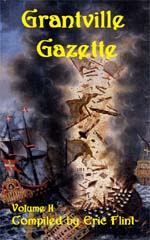
As you can perhaps deduce from the simple existence of a second issue of the Grantville Gazette, the first issue—which we did as an experiment, to see if there would be enough interest in such an online magazine—proved to be successful.
Quite successful, in fact, better than I'd hoped. As of today, we've sold about 1750 copies. With that sales base, the magazine can be financially self-sustaining, which was the prerequisite for being able to continue with it. I still can't afford to pay professional rates for the stories and articles—which the Science Fiction Writers' Association has now pegged at five cents a word—but I can cover all the other costs, including paying professional rates to a copy editor as well as the percentage received by Webscriptions and Baen Books. And I'm hoping—I think not unreasonably—that over time the magazine's sales and subscription base will become large enough that I can start paying professional rates for the stories and articles instead of the current semi-pro rates. In order to do that, I estimate we'd need a stable sales/sub base of around 2500 readers.
So... onward.
Now that I know the Gazette will be an ongoing publication, I've got more leeway in terms of the kind of stories I can include in the magazine. A number of the fiction pieces being written in the 1632 setting are either long or are intended as parts of ongoing stories. There are two examples in this issue: Danita Ewing's "An Invisible War"and Enrico Toro's "Euterpe, episode 1."In terms of its length, "An Invisible War" is technically a short novel. So, it'll be serialized over the next two issues of the magazine. Part I appears in this issue; the concluding part will appear in the next.
Enrico Toro's story is somewhat different. Neither he nor I know what the final length of this story will be. It's written in the form of episodes, each told in epistolary form by the narrator. I wanted to include it, because (along with Gorg Huff's story, "God's Gifts") Toro's piece approaches the 1632 framework entirely from the angle of how seventeenth-century people react to the events produced by the Ring of Fire.
Most of the stories that have thus far appeared in either the Gazette or the anthology Ring of Fire have approached the situation either entirely or primarily from the standpoint of up-timers. What I especially liked about the stories by Toro and Huff is that up-timers are never the viewpoint characters. In the case of "Euterpe," Toro is using an actual historical figure and trying to imagine how a young musician of the time would react to the sudden influx of music written over the next several centuries. In the case of Huff's story, the character is a fictional Lutheran pastor trying to grapple with the theological implications of the Ring of Fire.
Given that there are a few thousand up-timers in the 1632 setting—and tens of millions of down-timers—it seemed about time to me that we started getting more of their view of things into the series.
Although not quite to the same degree, Chris Weber's short novella "The Company Men" also approaches the setting primarily from the standpoint of seventeenth-century figures. In the case of his story, which is an adventure story, that of two mercenary soldiers of the time. And in John Zeek's murder mystery "Bottom Feeders," we get a nice mix of viewpoints.
There's a nice mix of stories in this issue, I think, in more ways than one. They range from military stories like Mike Spehar's "Collateral Damage" through stories involving the struggle to expand medical care (Ewing's "An Invisible War"), and everything in between. The same is true for the factual articles, where you'll get a treatise on seventeenth-century swordplay as well as a discussion of the practical challenges posed by geology and mining in the context of the technical resources available to the characters in the series.
I should mention that there is one major change in the magazine from the first issue. I'm no longer including an Images section as a part of the magazine itself. I did that for the first issue, and intended to continue. However, I failed to take into account that by including so many images in the magazine itself, it became difficult for many people to download in a reasonable time—and for those using PDAs, often effectively impossible.
So, while I will continue to expand the images provided, whenever I get the chance, I'm now going to do it separately from the magazine itself. That way people will be able to download the text of the magazine without any problems. The Images will now be found at a separate location as part of the Baen Free Library. The Baen Free Library is free of charge, so they won't cost you anything extra.
To find the images, do the following:
1) Go to Baen Books' web site: www.baen.com
2) Select "Free Library" from the menu at the top.
3) Once you're in the Library, select "The Authors" from the menu at the left.
4) Select "Eric Flint."
5) Select "Images from the Grantville Gazette."
Now that the images are disconnected from the Gazette itself, I'll be adding to them on a separate schedule. That'll make things easier for me, given my work load. Most likely, I'll add fewer images and commentary each time, but do it more often than the magazine itself appears.
Eric Flint
March, 2004